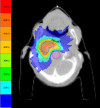The value of image-guided intensity-modulated radiotherapy in challenging clinical settings
- PMID: 23255544
- PMCID: PMC4651069
- DOI: 10.1259/bjr.20120278
The value of image-guided intensity-modulated radiotherapy in challenging clinical settings
Abstract
Objective: To illustrate the wider potential scope of image-guided intensity-modulated radiotherapy (IG-IMRT), outside of the "standard" indications for IMRT.
Methods: Nine challenging clinical cases were selected. All were treated with radical intent, although it was accepted that in several of the cases the probability of cure was low. IMRT alone was not adequate owing to the close proximity of the target to organs at risk, the risk of geographical miss, or the need to tighten planning margins, making image-guided radiotherapy an essential integral part of the treatment. Discrepancies between the initial planning scan and the daily on-treatment megavoltage CT were recorded for each case. The three-dimensional displacement was compared with the margin used to create the planning target volume (PTV).
Results: All but one patient achieved local control. Three patients developed metastatic disease but benefited from good local palliation; two have since died. A further patient died of an unrelated condition. Four patients are alive and well. Toxicity was low in all cases. Without daily image guidance, the PTV margin would have been insufficient to ensure complete coverage in 49% of fractions. It was inadequate by >3 mm in 19% of fractions, and by >5 mm in 9%.
Conclusion: IG-IMRT ensures accurate dose delivery to treat the target and avoid critical structures, acting as daily quality assurance for the delivery of complex IMRT plans. These patients could not have been adequately treated without image guidance.
Advances in knowledge: IG-IMRT can offer improved outcomes in less common clinical situations, where conventional techniques would provide suboptimal treatment.
Figures









References
-
- Pow EH, Kwong DL, McMillan AS, Wong MC, Sham JS, Leung LH, et al. Xerostomia and quality of life after intensity-modulated radiotherapy vs conventional radiotherapy for early-stage nasopharyngeal carcinoma: initial report on a randomized controlled clinical trial. Int J Radiat Oncol Biol Phys 2006;66:981–91. - PubMed
-
- Donovan E, Bleakley N, Denholm E, Evans P, Gothard L, Hanson J, et al. Breast Technology Group Randomised trial of standard 2D radiotherapy (RT) versus intensity modulated radiotherapy (IMRT) in patients prescribed breast radiotherapy. Radiother Oncol 2007;82:254–64. - PubMed
-
- Veldeman L, Madani I, Hulstaert F, De Meerleer G, Mareel M, De Neve W. Evidence behind use of intensity-modulated radiotherapy: a systematic review of comparative clinical studies. Lancet Oncol 2008;9:367–75. - PubMed
-
- Staffurth J. A review of the clinical evidence for intensity modulated radiotherapy. Clin Oncol (R Coll Radiol) 2010;22:643–57. - PubMed
Publication types
MeSH terms
Grants and funding
LinkOut - more resources
Full Text Sources
Other Literature Sources
Medical

